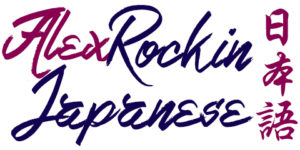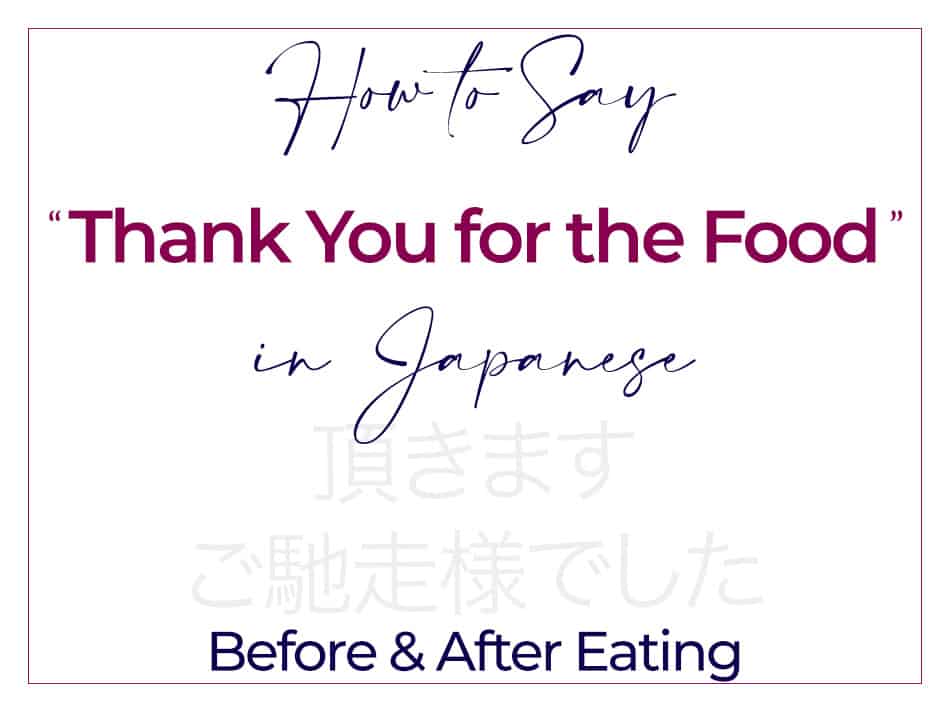Today I thought after finishing my lunch that saying “Thank you for the food” in Japanese can actually be a bit confusing. Especially if you have just started to learn Japanese since there are two different phrases. You have probably heard “Itadakimasu” and “Gochisousama deshita” before from anime like Naruto, but which one should you say before eating and which one after the meal?
“Itadakimasu” (頂きます) is the phrase Japanese people usually say before eating. It means “Thank you for the food” but literally translates as “I humbly receive this meal”. “Gochisousama deshita” (御馳走様でした) and “Gochisou sama” (御馳走様) also mean “Thank you for the meal/feast” but are said after eating.
In this blog post, I will go into more detail about what the two phrases actually mean and all the things Japanese people include in their appreciation and gratitude when they utter them. After that, you will also find a bunch of other useful phrases that you can use before eating to tell your guest “Enjoy your meal” and “Bon Appetit” in Japanese.
Itadakimasu – Thank You For the Food (Before Eating)
The literal meaning of itadakimasu (頂きます) is “I humbly receive” but it is comparable to “Let’s eat” or “Bon appétit” in western cultures. It is also often translated as “Thank you for the food” because the polite Japanese phrase expresses one’s gratitude and appreciation for the food before eating breakfast, lunch, or dinner.
One very important difference is that in contrast to “Bon appétit”, itadakimasu doesn’t mean “Enjoy your food” or “I hope you enjoy your food“. It is said by the person who is about to eat, but cannot be said to another person who is about to eat. For this, there is another phrase in Japanese we will learn further down below.
So remember you only use “Itadakimasu” when you receive food or when you are about to eat.
By saying “Itadakimasu” Japanese people acknowledge and appreciate not only the lives of the animals and plants that were taken in order to sustain their own life, but also the hard work of the farmers, chefs, and all other people that were involved and made it possible to receive this meal.
In Japan, most people say “Itadakimasu” before they start eating, even when they are alone. It is an important custom that they were taught back in kindergarten and school. Only a small number of people have stopped using the phrase, in recent years, mostly because they don’t think it is important.
While “Itadakimasu” is sometimes said individually by each person before they start their meal, it is more common for everyone to wait, say the phrase together, and start eating at the same time. For perfect etiquette, you should also put your hands together as you say it. Some people also bow.
If you want to write “Itadakimasu” in Japanese you can either write it in Kanji 頂きます or in Hiragana いただきます. Both versions are common.
| Itadakimasu Thank you for the food I will eat now Let’s eat Bon appétit | 頂きます いただきます |
Gochisousama Deshita – Thank You For The Meal (After Eating)
After eating, Japanese people express their gratitude and thanks for the food once more by saying gochisousama deshita (ご馳走様でした). The literal meaning of the phrase is “It was a feast” but it is commonly translated as “Thank you for the meal“, “What a wonderful meal“, or “That was a delicious meal“.
Similar to “Itadakimasu” Japanese people express their gratitude and thanks to everyone who was involved in preparing, cooking, and serving the meal by saying “Gochisousama deshita“. Since the word gochisou (ご馳走) means “feast” the phrase also conveys a lot of respect, even for a simple meal.
When you are eating with your partner, close friends, or alone you can also use the shorter and more casual version of “Gochisousama deshita” and just say gochisousama (ご馳走様). It means exactly the same “Thank you for the meal” or “What a wonderful meal“, but sounds less formal.
Japanese people also say “Gochisousama deshita” when leaving a restaurant. Either when they pay the bill or approach the cashier. It is also used to thank sushi or ramen chefs directly, especially when sitting at the counter. After paying or right before leaving the eatery you can say it once more.
You should do the same, when someone treats you to a meal, by the way. After the other person paid for you, it is polite to thank them by saying “Gochisousama (deshita)“. I usually tend to say it once more when saying goodbye (check out my post introducing 26 casual and formal ways to say goodbye in Japanese in case you don’t know how).
One tricky thing about this phrase is that it can be written in a lot of different ways. In English, you will encounter both “Gochisousama (deshita)” and “Gochiso sama (deshita)“. In Japanese, all of the following versions are correct: ご馳走様でした, ご馳走さまでした, 御馳走様でした, and ごちそうさまでした.
| Gochisousama deshita Thank you for the meal Thank you for the feast That was a delicious meal What a wonderful meal It was a feast | ご馳走様でした ご馳走さまでした 御馳走様でした ごちそうさまでした |
| Gochisousama Thank you for the meal Thank you for the feast That was a delicious meal What a wonderful meal It was a feast | ご馳走様 ご馳走さま 御馳走様 ごちそうさま |
“Enjoy Your Meal” and “Bon Appetit” in Japanese
Bonapeti (ボナペティ) is “bon appetit” in Japanese, but it is rarely used. The more commonly used phrase in Japanese is “Meshiagre” (召し上がれ) which can be translated as “Bon appetit” or “Dig in” and the politer “Douzo, o-meshi agari kudasai” (どうぞ、お召し上がりください) which is “Please enjoy your meal” in English.
Meshiagare – “Enjoy Your Meal” in Japanese
Meshiagare (召し上がれ) is another phrase Japanese people say before eating that means “Enjoy your meal” or “Bon appetit“. In contrast to “Itadakimasu”, it can be said to another person who is about to eat and it is used by the chef or host to indicate that the meal is served and that it is time to eat.
So whenever you have cooked for your friends or for your partner you can tell them to “Dig in” by saying “Meshiagare” (召し上がれ) or use “Douzo, meshiagare” (どうぞ、召し上がれ) to wish them “Bon appetit“.
In a more formal setting, you should rather use or will probably hear the polite “Douzo, o-meshi agari kudasai” (どうぞ、お召し上がりください) which usually means “Please enjoy your meal” but can also be translated as “Please help yourself“. Use this phrase when you get the chance to cook or bake something for your boss, senior, etc.
There are a few variations of this phrase that you can use in real-life situations. Below you will find the most important ones starting with the politest of them. Please be aware that all of the phrases can actually be translated in the same way. However, I tried to go for distinct translations to emphasize the different politeness levels.
| Douzo, o-meshi agari kudasai Please enjoy your meal! Please help yourself! | どうぞ、お召し上がりください |
| O-meshi agari kudasai Enjoy your meal! Bon appétit! | お召し上がりください |
| Douzo, meshiagare Here you go. Enjoy! Go ahead, eat up! | どうぞ、召し上がれ |
| Meshiagare Bon appétit! Dig in! | 召し上がれ |
Bonapeti – “Bon Appétit” in Japanese
Bonapeti (ボナペティ) is the Japanized version of the French phrase “Bon Appétit“. You will find it in dictionaries (source), but so far I haven’t heard it being used even once. Neither by my friends nor by strangers in the same restaurant or room. So it is definitely a rare phrase that is hardly ever used. My advice: Stick with “Meshiagre” even though it might be more difficult to remember.
| Bonapeti Bon appétit! | ボナペティ |



Danke, wahr hilfreich! Schön, dass es andere Deutsche gibt, die Japan so lieben.
Gehe demnächst in ein japanisches Restaurant und möchte dort gefallen.
Mir geht’s auch so, wohne in einem kleinen Dorf nicht weit von Wiesbaden, aber fast keine Japanisch kenntnisse. Lernen und Pauken ist leider nicht so meine Stärke.
Würde auch gerne mal Japan besuchen, aber das ‘echte’ Japan, nicht die Touristen-Sachen. Authentisches Japan. Gibt’s da etwas, was du kennst? Sowas wie authentische Guides?
Hey Cornelius (⌒‐⌒)ノ
Vielen lieben Dank fuer dein Kommentar! Es ist schoen zu sehen dass auch Deutsche meinen Blog finden!
Meine Erfahrung hat mir gezeigt dass “immersion” viel wichtiger und effizienter ist als stures Lernen und Pauken.
Ich habe mein Japanisch am schnellsten verbessert als ich angefangen habe es jeden Tag irgendwie zu nutzen.
Hmm…ganz ehrlich die meisten “Touristen-Sachen” hier in Japan sind sehr authentisch. Tokyo und Kyoto sind genauso das echte Japan wie Tsuruoka und Hyuga. Jede Stadt und jedes Fleckchen haben ihren eigenen Charm und lokale Koestlichkeiten. Das ist das Schoene an Japan. Du musst nur wissen was dich wirklich interessiert und was du erleben willst.
Ich habe meine eigene Travel Guide Webseite fuer Japan (www.alexrockinjapan.com) aber die steht noch ganz am Anfang und bisher hatte ich nur Zeit ueber hot springs zu schreiben. Als ich damals durch Japan gereist bin habe ich Japan Guide und Lonely Planet benutzt und ich habe nichts bereut.
Ich hoffe das hilft!
Alex (⌒‐⌒)♪